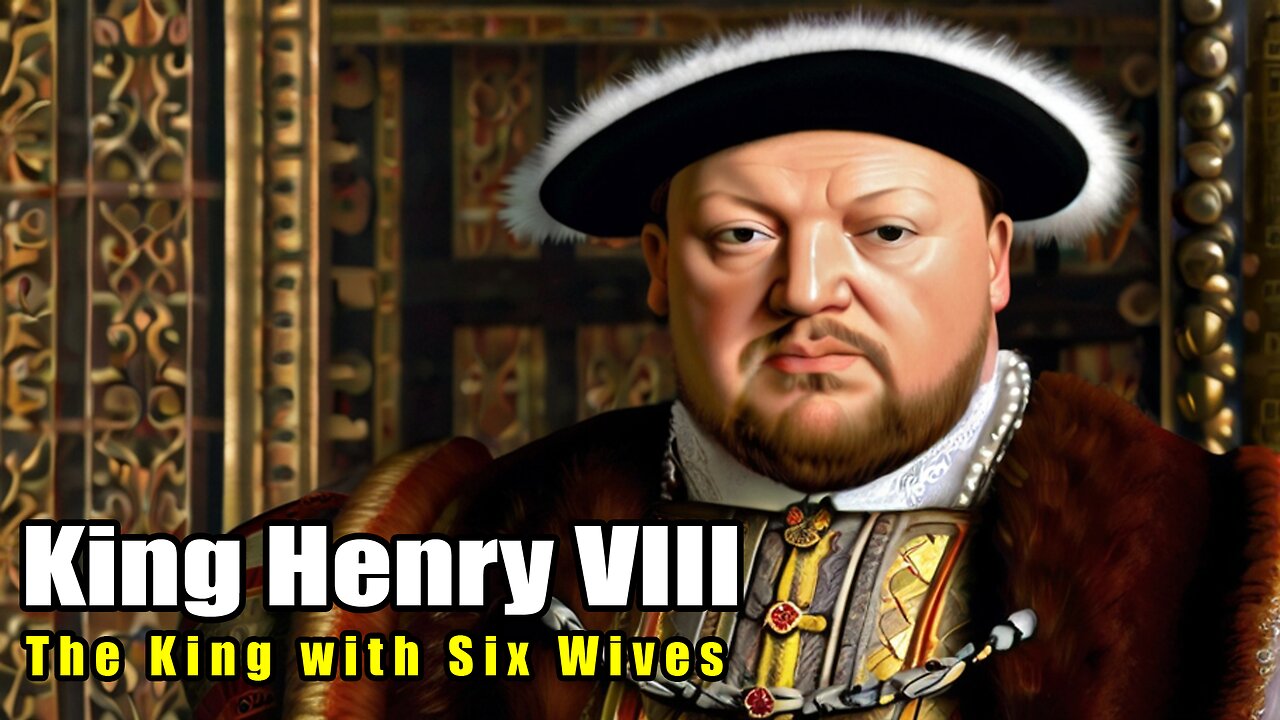Premium Only Content

Henry VIII - The King with Six Wives (1491 - 1547)
Henry VIII (1491-1547) was the second Tudor monarch of England and one of the most well-known and controversial kings in English history. His reign, which began in 1509, is particularly noted for his six marriages and his role in the English Reformation. Here is an overview of Henry VIII's life and his notable marriages:
Early Life:
Born into Royalty:
Henry VIII was born on June 28, 1491, at the Palace of Placentia in Greenwich, England, the second son of King Henry VII and Elizabeth of York.
Education and Interests:
He received a comprehensive education and developed an interest in music, sports, and theology.
Marriages:
Catherine of Aragon (m. 1509-1533):
Henry's first wife was Catherine of Aragon, the widow of his elder brother Arthur. Their marriage lasted for over two decades, but Catherine failed to produce a male heir who survived infancy.
Anne Boleyn (m. 1533-1536):
Henry's desire for a male heir led to his split from the Catholic Church. He married Anne Boleyn in 1533, but their marriage was marked by political and personal turmoil.
Jane Seymour (m. 1536-1537):
Jane Seymour, Henry's third wife, finally provided him with a male heir, the future Edward VI. Unfortunately, she died shortly after giving birth.
Anne of Cleves (m. 1540-1540):
Henry's marriage to Anne of Cleves was annulled after a short period, and they remained friends. The annulment led to the establishment of the Church of England.
Catherine Howard (m. 1540-1542):
Catherine Howard, Henry's fifth wife, was executed for adultery after only a short marriage.
Catherine Parr (m. 1543-1547):
Catherine Parr, Henry's sixth and final wife, outlived him. She married again after Henry's death.
Political and Religious Changes:
Break with the Catholic Church:
Henry's desire for a male heir, coupled with his discontent with the Pope's refusal to annul his marriage to Catherine of Aragon, led to the English Reformation.
Formation of the Church of England:
In 1534, the Act of Supremacy declared the English monarch as the head of the Church of England, effectively separating it from the authority of the Pope.
Dissolution of the Monasteries:
Henry initiated the dissolution of monasteries in England, confiscating their wealth and redistributing land.
Political Maneuvers and Challenges:
Military Campaigns:
Henry engaged in military campaigns, including wars with France and Scotland. The Battle of Flodden in 1513 was a notable victory for England.
Treaty of Windsor (1522):
The Treaty of Windsor strengthened the alliance between England and Spain.
Act of Succession (1534):
The Act of Succession, enacted in 1534, declared Anne Boleyn's children, including Elizabeth I, as legitimate heirs to the throne.
Later Years and Death:
Health Decline:
In his later years, Henry suffered from health issues, including obesity and a leg wound that may have contributed to his deteriorating physical condition.
Death:
Henry VIII died on January 28, 1547, at the Palace of Whitehall. He was succeeded by his young son, Edward VI.
Legacy:
Impact on English History:
Henry VIII's reign had a profound impact on English history, marking the beginning of the English Reformation and the establishment of the Church of England.
Tudor Dynasty:
His reign is also associated with the Tudor dynasty, which included his children Edward VI, Mary I, and Elizabeth I.
Cultural Influence:
Henry's life, marriages, and political maneuvering have inspired numerous literary and artistic works, including William Shakespeare's play "Henry VIII."
Henry VIII's reign is often remembered for his marital escapades, political machinations, and the significant religious changes that shaped the course of English history.
-
 16:29
16:29
Mrgunsngear
1 day ago $0.72 earnedGirsan Witness 2311 Match X - Staccato XC On A Budget But Does It Work?
4.97K4 -
 14:54
14:54
Tundra Tactical
1 hour agoTundy's SIG MEME Review 2: The Reload!!!
2.03K1 -
 LIVE
LIVE
EricJohnPizzaArtist
5 days agoAwesome Sauce PIZZA ART LIVE Ep. #56: Bret “The Hitman” Hart Tribute with SoundBoardLord!
285 watching -
 LIVE
LIVE
GritsGG
6 hours agoWin Streaking! Most Wins 3180+! 🔥
329 watching -
 LIVE
LIVE
Due Dissidence
6 hours agoGaza STARVATION Hits Tipping Point, Flotilla CAPTURED, Bongino BREAKS SILENCE, Maxwell MEETS DOJ,
1,450 watching -
 26:54
26:54
Eat Sleep Cruise
2 days agoWe Tested The 10 Best Cruises for Couples - Here's How They Rank!
1.29K2 -
 33:05
33:05
CarlCrusher
1 day agoLand of the Giants | Return to the Sacred Spirit Canyon - Ep 1
1.21K4 -
 26:37
26:37
Fat Lip Collective
11 days agoHow I Designed 3D-Printed Mods for My Vintage Toyota KE25
5011 -
 18:04
18:04
LivingontheEmeraldCoastFlorida
14 days agoFREEPORT, FLORIDA! PROS AND CONS | The ULTIMATE moving guide! Full VLOG tour
349 -
 30:38
30:38
sewgarage
5 days agoGOLF MK2 dashboard upholstery process
323